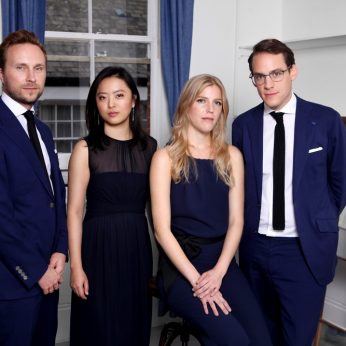Composer: Béla Bartók (b. 1881 - d. 1945)
Performance date: 27/06/2022
Venue: Bantry House
Composition Year: 1917
Duration: 00:29:26
Recording Engineer: Eduardo Prado, Ergodos
Instrumentation: 2vn, va, vc
Instrumentation Category:String Quartet
Artists:
Doric String Quartet (Alex Redington, Ying Xue [violins], Hélène Clément [viola], John Myerscough [cello] -
[quartet]

Béla Bartók [1881-1945]
String Quartet No.2 in A minor Op.17 [1915-17]
1. Moderato
2. Allegro molto capriccioso
3. Lento
Béla Bartók’ was disturbed by the cruelty of First World War and found it hard to compose during those years, so instead devoted himself to studying folk music in Hungary, Romania and North Africa. The Second String Quartet, Op.17, dates from between 1915 and 1917. Following the completion of his First String Quartet, Bartók wrote with increasing confidence for the stage: witness his only opera, Duke Bluebeard’s Castle (1911, revised 1917) or the ballet The Wooden Prince (also 1917). His compatriot Zoltán Kodály called the quartet’s three movements, A Quiet Life, Joy and Sorrow. As those ‘titles’ might suggest, each is very different in character.
The quiet life of the first movement could also refer to the virtual seclusion that Bartók lived in with his wife outside Budapest whilst writing the work. The movement also presents a couple of different compositional concerns that would occupy Bartók in the years ahead. Notable amongst these is the nature of dissonance as an ingredient in a musical discourse. Rather than seeing dissonance as an element in isolation, for Bartók dissonance does not preclude lyricism. The use of musical mottos would become a commonly used compositional device. In the opening movement, the first violin’s repeated use of rising three note sequences are heard before others are introduced. A recapitulation reinforces the importance of the thematic material and the coda builds in intensity before dissipating.
The use of repeated notes induces the second movement’s sense of constant motion, which is punctuated for dramatic effect by carefully placed pauses. Listen carefully, and it is possible to pick up the suggestion of a ghostly waltz. However, it is the strident presentation of a Hungarian folk dance that is the movement’s most noteworthy feature.
The final movement captures the desolation that Bartók observed during the war. The three note motif from the first movement is used again, this time as a mournful dirge of brooding introspection. The scoring initially treats the forces not as a quartet, but as two pairs of duos. If the movement proves to be emotionally searching, upon reaching its conclusion the feeling is more one of fragility.
© Evan Dickerson
Copyright © 2025 West Cork Music. All rights reserved.
Designed and developed by Matrix Internet